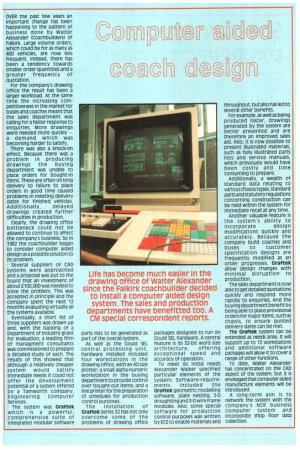m - nylerf s!d ach deeg OVER the past few years an
Page 54

If you've noticed an error in this article please click here to report it so we can fix it.
important change has been happening to the pattern of business done by Walter Alexander (Coachbuilders) of Falkirk. Large volume orders, which could be for as many as 400 vehicles, are now less frequent. Instead, there has been a tendency towards smaller order quantities and a greater frequency of quotation.
For the company's drawing office the result has been a larger workload. At the same time the increasing competitiveness in the market for buses and coaches meant that the sales department was calling for a faster response to enquiries. More drawings were needed more quickly — a demand which was becoming harder to satisfy.
Therewas also a knock-on effect. Because there was a problem in producing drawings the buying department was unable to place orders for bought-in items. These are often on long delivery so failure to place orders in good time caused problems in meeting delivery dates for finished vehicles.
Additionally, delayed drawings created further difficulties in production.
Clearly, the drawing office bottleneck could not be allowed to continue to affect the company's business. So in 1982 the coachbuilder began to consider computer aided design as a possible solution to its problem.
Several suppliers of CAD systems were approached and a proposal was put to the board that an investment of about 2100,000 was needed to solve the problem. This was accepted in principle and the company spent the next 12 months evaluating virtually all the systems available.
Eventually, a short list of three suppliers was drawn up and, with the backing of a Department of Industry grant for evaluation, a leading firm of managment consultants was commissioned to prepare a detailed study of each. The results of this showed that although a relatively cheaper system would satisfy immediate needs it could not offer the development potential of a system offered by a Tamworth company, Engineering Computer Services.
The system was Graftek which is a powerful, comprehensive suite of integrated modular software parts lists to be generated as part of the overall system.
As well as the Gould SEL central processing unit, hardware installed included four workstations in the drawing office, with an AO size plotter; a small alpha-numeric workstation in the buying department to provide control over bought-out items; and a line printerforthe preparation of schedules for production control purposes.
The installation of Graftek Series 32 has not only overcome some of the problems of drawing office packages designed to run on Gould SEL hardware. A central feature is its 32-bit word size architecture, offering exceptional speed and accuracy of operation.
To meet its initial needs Alexander Walker specified particular elements of the system. Software-requirements included the Graftek geometric modelling software, plate nesting, 3-D draughting and 3-Dwireframe modules. Also, some special software for production control purposes was written by ECS to enable materials and throughput, but also has led to several other benefits.
For example, as well as being produced faster, drawings generated by the system are better presented and are therefore an improved sales aid. Also, it is now possible to present illustrated materials, such as fully illustrated parts lists and service manuals, which previously would have been costly and time consuming to prepare.
Additionally, a wealth of standard data relating to various chassistypes, standard parts and statutory regulations concerning construction can be held within the system for immediate recall at any time.
Another valuable feature is the system's ability to incorporate design modifications quickly and accurately. Because the company build coaches and buses to customer specification designs are frequently modified as an order progresses. Graftek allow design changes with minimal disruption to production.
The sales department is now able to get detailed quotations quickly and respond more rapidly to enquiries. And the buying department benefit by being able to place provisional orders for major items, such as chassis, to ensure quoted delivery dates can be met.
The Graftek system can be extended as needs arise. It will support up to 12 workstations and additional software packages will allow it to cover a range of other functions.
To date, Walter Alexander has concentrated on the CAD aspect of the system, but it is envisaged that computer aided manufacture elements will be introduced.
A long-term aim is to network the system with the company's NCR business computer system and incorporate shop floor data collection.




































































































